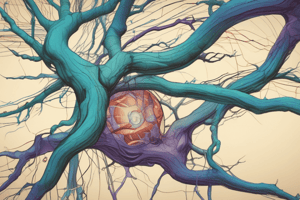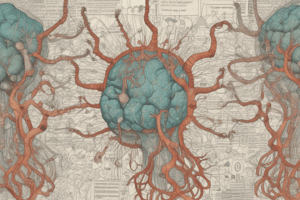Podcast
Questions and Answers
What are the specialized junctions called where neurons communicate with each other?
What are the specialized junctions called where neurons communicate with each other?
- Hormones
- Synapses (correct)
- Nucleotides
- Neurotransmitters
Which of the following is NOT a common neurotransmitter?
Which of the following is NOT a common neurotransmitter?
- GABA
- Serotonin
- Dopamine
- Insulin (correct)
What type of cells are responsible for transmitting information throughout the body via electrical and chemical signals?
What type of cells are responsible for transmitting information throughout the body via electrical and chemical signals?
- Adipocytes
- Neurons (correct)
- Fibroblasts
- Red Blood Cells
Which of the following is NOT an example of a neurotransmitter?
Which of the following is NOT an example of a neurotransmitter?
What is the narrow space between two nerve cells where neurotransmitters are released?
What is the narrow space between two nerve cells where neurotransmitters are released?
What is the term for the electrical signals that travel along neurons?
What is the term for the electrical signals that travel along neurons?
What are the three main parts of a neuron?
What are the three main parts of a neuron?
Which part of a neuron receives incoming messages from other neurons?
Which part of a neuron receives incoming messages from other neurons?
What is the purpose of neurotransmitters in synaptic transmission?
What is the purpose of neurotransmitters in synaptic transmission?
What triggers the opening of voltage-gated ion channels during an action potential?
What triggers the opening of voltage-gated ion channels during an action potential?
What happens when the membrane potential of a neuron changes from negative to positive during an action potential?
What happens when the membrane potential of a neuron changes from negative to positive during an action potential?
Which factor affects synaptic transmission related to the strength of connection between neurons?
Which factor affects synaptic transmission related to the strength of connection between neurons?
Flashcards are hidden until you start studying
Study Notes
Neurophysiology
Neurophysiology is a branch of biomedical science concerned with the study of the physiological responses of the nervous system in both health and disease states. It is a multidisciplinary field incorporating aspects of biochemistry, genetics, pharmacology, mathematics, physics, engineering, computer science, psychology, anthropology, sociology, economics, and linguistics. In this article, we will discuss some key concepts within neurophysiology including neurotransmitters, neurons, synaptic transmission, and action potentials.
Neurotransmitters
Neurons communicate with each other through specialized junctions called synapses where they release chemical messengers known as neurotransmitters into the narrow space between two nerve cells, called the synaptic cleft. These chemicals have specific effects on target neurons and can influence their excitability or activity by binding to receptor proteins located on the surface of these cells. Some common neurotransmitters include dopamine, serotonin, acetylcholine, GABA, glutamate, histamine, norepinephrine, and epinephrine. Each neurotransmitter has its own unique mechanism of action, which is determined by the type of receptors it binds to and the signaling pathways it activates within the target cell.
Neurons
Neurons are specialized cells responsible for transmitting information throughout the body via electrical and chemical signals. They typically have three main parts: the cell body or soma, dendrites, and axon. Dendrites receive incoming messages from other neurons, while the axon sends outgoing messages to other neurons or muscles. The ends of the axon may form large branches, called terminals, which contain vesicles filled with neurotransmitters, ready to release them across a synapse. There are several types of neurons, classified based on their structure and function, such as sensory neurons, motor neurons, and interneurons.
Synaptic Transmission
Synaptic transmission refers to the process by which a chemical signal called a neurotransmitter is released from one neuron at a synapse and received by the next neuron, allowing communication between multiple neurons. This occurs when the postsynaptic neuron receives chemical messages from presynaptic neurons through neurotransmitters. Two important factors affect synaptic transmission: the strength of the connection between the pre-synaptic and post-synaptic neurons, and whether the synapse is excitatory or inhibitory.
Action Potentials
An action potential is a brief burst of electrochemical impulses generated by neurons in response to stimuli. When a neuron's membrane becomes depolarized beyond a certain threshold, the membrane potential rapidly changes from negative to positive, triggering the opening of voltage-gated ion channels. This allows positively charged sodium ions to flow into the neuron, generating an electric current that travels along the axon. As the action potential propagates down the axon, it causes other areas of the neuron to become more permeable to potassium ions, leading to the repolarization phase of the action potential.
Studying That Suits You
Use AI to generate personalized quizzes and flashcards to suit your learning preferences.




